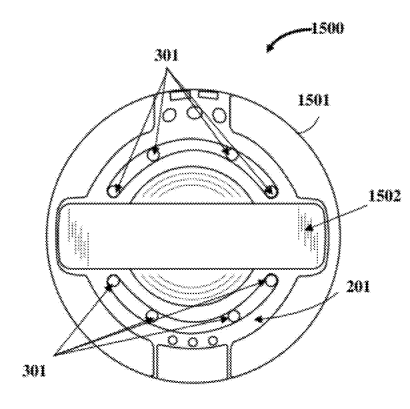
by Dennis Crouch
Vocalife LLC v. Amazon.com, Inc. (Fed. Cir. 2022) (non-precedential)
Vocalife’s patent addresses an improved microphone procedure that identifies the location of a goal audio source and then makes use of beamforming to make improvements to seem collection from the goal. U.S. Patent No. RE 47,049. The process for finding the sound requires an array of microphones that record relative timing of getting appears. The delay is then used to estimate the location and then direct the beamforming functions.
A vital aspect of the promises is as a result the necessity of “determining a hold off among each and every of mentioned audio sensors . . . wherein reported determination of said delay permits beamforming for claimed array of audio sensors in a plurality of configurations.” RE47,049, Declare 1.

A jury sided with Vocalife–finding that Amazon induced its shoppers to infringe through their use of the Echo item and award $5 million in damages. Choose Gilstrap upheld the verdict–denying Amazon’s renewed movement for Judgement as a Matter of Legislation (JMOL). On attractiveness on the other hand, the Federal Circuit has reversed acquiring that the evidence didn’t verify these crucial restrictions.
Amazon states in its documentation that its echo equipment incorporate various microphones that empower beamforming. The challenge while is that just about every echo gadget has a unique physical arrangement and thus does not satisfy the prerequisite that the method is effective “in a plurality of configurations.” As spelled out by Choose Gilstrap: “Amazon argues that, even if the Accused Items identify a hold off in the fashion Vocalife contends, this sort of is accomplished for a one geometric structure of microphones and not for a plurality of layouts.” But at demo, Amazon’s own witness discussed that the microphone configuration “varies from product-to-solution. Anywhere from two to eight microphones are in our solutions today.” Vocalife’s specialist then testified that the code is intended in a way that it is operable throughout the numerous Echo devices–i.e., it is effective “in a plurality of configurations” as demanded by the statements. The very same code operates irrespective of the configuration. So, we have a basic declare construction problem as to no matter whether a single device needs to be able of operating in a plurality of configurations. Amazon argues that this is answered by promises themselves that state that the strategy enables “the mentioned array of sound sensors in a plurality of configurations.” On the other hand, the patent alone discloses embodiments that look to use fixed relative sensor spots – as in the microphone array revealed beneath.

Amazon did not attractiveness the jury verdict straight, but alternatively the district court’s refusal to grant JMOL whose normal asks no matter if there was adequate evidence introduced at demo these kinds of that a affordable jury could have dominated in the same way that the actual jury dominated. The jury have to be offered a strong reward-of-the-question and the courts should consider treatment to prevent “re-examining” any fact tried using by the jury since that is prohibited by the U.S. Structure Seventh Amendment. The regular method then appears to be like to the things that the winning party experienced to prove in order to gain its scenario and look at irrespective of whether any aspects suffers from a complete absence of evidence. Here while there was some proof supporting the jury verdict — in that set up, the district courtroom must only grant JMOL when “the points and inferences point so strongly and overwhelmingly in favor of one particular social gathering that the courtroom concludes that acceptable jurors could not arrive at a contrary verdict.” Orion IP, LLC v. Hyundai Motor Am., 605 F.3d 967 (Fed. Cir. 2010) (implementing Fifth Circuit law).
In its brief decision, the Federal Circuit implicitly identified the declare construction question (even although declare construction was not appealed) and identified that Amazon’s offering of numerous merchandise would not induce infringement. Rather, the court uncovered that infringement proof will have to clearly show that “a provided Echo device” need to help beamforming “in a plurality of configurations.” Maybe the up coming reissue will be in a position to resolve the promises when once more.
= = =
Intervening Rights and Process Claims: As mentioned over, the patent at situation listed here is a reissue patent. Reissue will involve surrendering the primary patent and then heading as a result of a new prosecution process that, in this scenario, included various amendments to the promises. The district court docket located that some of the patentee’s back again-statements from prior to the reissue were being barred by the doctrine of absolute intervening legal rights defined by 35 U.S.C. § 252.
[A]ny particular person . . . who, prior to the grant of a reissue, made, obtained, offered to offer, or made use of within just the United States, or imported into the United States, anything patented by the reissued patent, to carry on the use of, to give to offer, or to offer to others to be employed, supplied for sale, or sold, the particular detail so made, ordered, available for sale, utilized, or imported except if the building, making use of, supplying for sale, or providing of such implement to certain Echo products.
35 U.S.C. 252. In a cross enchantment, the patentee argued that the this provision really should not implement in its scenario because the claims are directed toward a method instead than a product or service. “Absolute intervening legal rights implement only to patented solutions produced, used, or
marketed right before the issuance of the reissue, and not to procedures or methods.” Patentee short.
The Federal Circuit has not particularly addressed this problem of how the intervening rights use to method or procedure promises. On charm here, the Federal Circuit refused to have interaction. Its finding of non-infringement rendered the issue moot.




